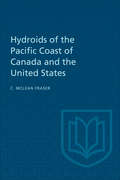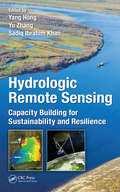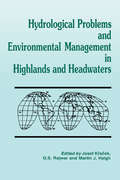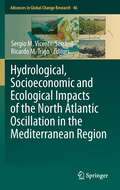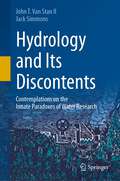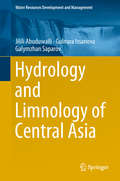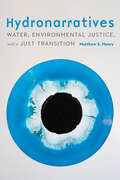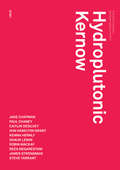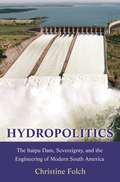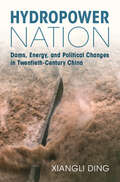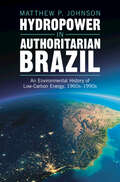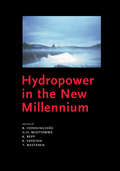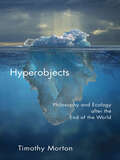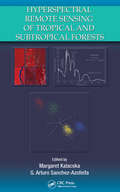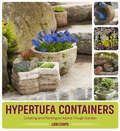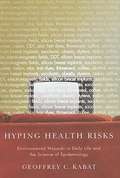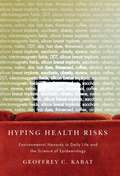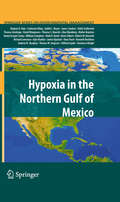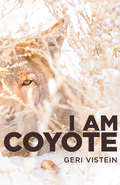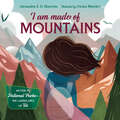- Table View
- List View
Hydroids of the Pacific Coast of Canada and the United States
by Charles McLean FraserHydroids of the Pacific Coast of Canada and the United States is an attempt to give a brief description, with figures, of every hydroid species known to occur along the Pacific Coast of Canada and the United States, together with its distribution within this area. It is intended to provide the Pacific zoologist with a reference, easily understood, to every species of hydroid reported from the coast. Keys to families, genera, and species have been included to facilitate diagnosis. Much of the information presented has already been published, but in widely scattered papers, some of them long out of print. The new contribution is largely in the extensive addition to the distribution records, for which many thousands of specimens have been examined.
Hydrologic Remote Sensing: Capacity Building for Sustainability and Resilience
by Yu Zhang Yang Hong Sadiq Ibrahim KhanEnvironmental remote sensing plays a critical role in observing key hydrological components such as precipitation, soil moisture, evapotranspiration and total water storage on a global scale. As water security is one of the most critical issues in the world, satellite remote sensing techniques are of particular importance for emerging regions which have inadequate in-situ gauge observations. This book reviews multiple remote sensing observations, the application of remote sensing in hydrological modeling, data assimilation and hydrological capacity building in emerging regions.
Hydrological Problems and Environmental Management in Highlands and Headwaters: Updating The Proceedings Of The First And Second International Conferences On Headwater Control
by Martin HaighThis set of papers presents a description of the synthesis of hydrological problems and various environmental implications and management strategies for different highland and headwater regions of the world. Regions covered include the Himalayas, Russian mountains, Amazonia, and upland Wales.
Hydrological, Socioeconomic and Ecological Impacts of the North Atlantic Oscillation in the Mediterranean Region
by Sergio M. Vicente-Serrano Ricardo M. TrigoThe Mediterranean basin represents one of the most important "hot spots" of climate change in the world, with recent trends towards a hotter and drier climate being related to changes in atmospheric circulation patterns. Such changes can have significant impacts in the climate of this region but also on the natural environment and several socioeconomic activities. Among these patterns, the North Atlantic Oscillation (NAO) is one of the main forcing factors in the region with impact on extreme events such as droughts, severe precipitations or heat and cold waves, the availability of water resources, the ecological dynamics, the quality and quantity of crops, the migration and welfare of animal populations, the fisheries dynamics, the triggering of landslides and the air pollution and human health, among others. The aim of Hydrological, Socioeconomic and Ecological Impacts of the North Atlantic Oscillation in the Mediterranean Region, is to serve as an updated reference text that covers the wide range of evidences on the NAO impacts in the Mediterranean regions and from a multidisciplinary perspective. This volume constitutes a unique document to present the state of the art of the numerous studies undertaken on the hydrological, socioeconomic and ecological impact of the NAO, collecting the expertise of researchers from several complementary earth science fields (geography, hydrology, remote-sensing, climatology, agriculture, energy), but that have been lacking a common ground.
Hydrology and Its Discontents: Contemplations on the Innate Paradoxes of Water Research
by Jack Simmons John T. Van Stan IIThis book examines the intricate web linking water science and society using diverse philosophical lenses. Highlighting the tensions within the threads of this web, we spotlight major conceptual tightropes that water researchers tread daily. To effectively navigate these delicate threads, a 'healthy' tension in the encompassing web is necessary. Drawing inspiration from Freud's examination of tensions in "Society and Its Discontents," we illuminate the tension-filled paradoxes inherent to water science, emphasizing the challenges in keeping these paradoxical threads taut enough to ensure a navigable and sustainable bond with society. Central to our narrative is the escalating societal urge to quantify and 'manage' water—something interwoven throughout every environmental layer, including the fabric of our being. An excessive focus on management may alienate users from their water realities, jeopardizing the vital threads that sustainability tether water science and society. Consequently, this book explores compelling and inescapable tensions that resist tidy universal resolution, such as: the language of water science, including its mathematical reductions (i.e., models); the effect of water's commodification on its science; hydrology’s intersection with colonialism; and other concerns that reveal distortions in our hydrology. We aim to aid water professionals in recognizing and fine-tuning the paradoxes intrinsic to their work. To underscore the interwoven complexity of contemporary hydrology, "Hydrology and Its Discontents" guides readers into the tempestuous depths of water research, all the while urging a recalibration of perspectives and motivations.
Hydrology and Limnology of Central Asia (Water Resources Development and Management)
by Gulnura Issanova Jilili Abuduwaili Galymzhan SaparovThis book highlights the development of lake systems and water reservoirs as well as the impact of climate change on water resources in Central Asian countries. It provides information on the genesis of lake basins, physical and chemical properties of water in lakes, and the hydrological regimes (water balance and fluctuation levels) of lakes of Central Asia and Xinjiang. The book is useful for scientists and researchers whose work focuses on lakes and the use of natural resources, irrigation, hydropower and water supply, as well as for students and planners.
Hydronarratives: Water, Environmental Justice, and a Just Transition
by Matthew S. HenryThe story of water in the United States is one of ecosystemic disruption and social injustice. From the Standing Rock Indian Reservation and Flint, Michigan, to the Appalachian coal and gas fields and the Gulf Coast, low-income communities, Indigenous communities, and communities of color face the disproportionate effects of floods, droughts, sea level rise, and water contamination. In Hydronarratives Matthew S. Henry examines cultural representations that imagine a just transition, a concept rooted in the U.S. labor and environmental justice movements to describe an alternative economic paradigm predicated on sustainability, economic and social equity, and climate resilience. Focused on regions of water insecurity, from central Arizona to central Appalachia, Henry explores how writers, artists, and activists have creatively responded to intensifying water crises in the United States and argues that narrative and storytelling are critical to environmental and social justice advocacy. By drawing on a wide and comprehensive range of narrative texts, historical documentation, policy papers, and literary and cultural scholarship, Henry presents a timely project that examines the social movement, just transition, and the logic of the Green New Deal, in addition to contemporary visions of environmental justice.
Hydroplutonic Kernow
by Robin MackayA geophilosophical odyssey through the remains of Cornwall's industrial past offers a historical portrait of geotrauma in action. This unique document provides a pioneering case study in post-“site-specific” geophilosophy. Based on a weird field trip into Cornwall's mining heartlands with geologists, philosophers, and ecologists as guides, Hydroplutonic Kernow drills down through nature, industry, and cultural capital to site the local within the global, unfolding the telluric plots that manipulated populations and devastated the landscape during the industrial age. In doing so, it provides a historical portrait of geotrauma in action.This geophilosophical odyssey takes us through the remains of the region's industrial past, reading them through the twisted prism of the geocosmic theory of trauma espoused by legendary “cryptographer” Dr. Daniel Barker and further developed by Iranian philosopher Reza Negarestani, and uncovering the deep plot of the Hydroplutonic Conspiracy, the collusion between water and the depths of the earth. Along with full documentation of the trip, the book also contains exegetical materials including an essay by Reza Negarestani, a poem by Jake Chapman, a preface by Caitlin DeSilvey, and an in-depth interview with Mining Engineer Steve Tarrant.
Hydropolitics, Interest Groups and Governance
by Richard MeissnerThis book investigates the role that interest groups have played over the years in influencing the government of Namibia, the World Bank, the European Union and project implementation authorities to not construct the proposed Epupa Hydroelectric Power Station on the Kunene River in the Baynes mountains, a region on the border between Namibia and Angola. Some of the issues brought forward by the interest groups are the socio-economic impact the dam would have on the OvaHimba, as well as negative consequences for the river's aquatic and terrestrial environment. This book argues that interest groups and individuals have the ability to influence the above-mentioned institutions, and to such an extent that water politics and governance are not exclusively the domain of state institutions. As such, it argues that communal interest groups, living in remote parts of the world, can influence state institutions at various political scales.
Hydropolitics: The Itaipu Dam, Sovereignty, and the Engineering of Modern South America (Princeton Studies in Culture and Technology #20)
by Professor Christine FolchAn in-depth look at the people and institutions connected with the Itaipu Dam, the world’s biggest producer of renewable energyHydropolitics is a groundbreaking investigation of the world’s largest power plant and the ways the energy we use shapes politics and economics. Itaipu Binational Hydroelectric Dam straddles the Paraná River border that divides the two countries that equally co-own the dam, Brazil and Paraguay. It generates the carbon-free electricity that powers industry in both the giant of South America and one of the smallest economies of the region. Based on unprecedented access to energy decision makers, Christine Folch reveals how Paraguayans harness the dam to engineer wealth, power, and sovereignty, demonstrating how energy capture influences social structures.During the dam’s construction under the right-wing military government of Alfredo Stroessner and later during the leftist presidency of liberation theologian Fernando Lugo, the dam became central to debates about development, governance, and prosperity. Dams not only change landscapes; Folch asserts that the properties of water, transmuted by dams, change states. She argues that the dam converts water into electricity and money to produce hydropolitics through its physical infrastructure, the financial liquidity of energy monies, and the international legal agreements managing transboundary water resources between Brazil and Paraguay, and their neighbors Argentina, Bolivia, and Uruguay.Looking at the fraught political discussions about the future of the world’s single largest producer of renewable energy, Hydropolitics explores how this massive public works project touches the lives of all who are linked to it.
Hydropower Nation: Dams, Energy, and Political Changes in Twentieth-Century China (Studies in Environment and History)
by Xiangli DingChina has the largest electricity generation capacity in the world today. Its number of large dams is second to none. Xiangli Ding provides a historical understanding of China's ever-growing energy demands and how they have affected its rivers, wild species, and millions of residents. River management has been an essential state responsibility throughout Chinese history. In the industrial age, with the global proliferation of concrete dam technology, people started to demand more from rivers, particularly when required for electricity production. Yet hydropower projects are always more than a technological engineering enterprise, layered with political, social, and environmental meaning. Through an examination of specific hydroelectric power projects, the activities of engineers, and the experience of local communities and species, Ding offers a fresh perspective on twentieth-century China from environmental and technological perspectives.
Hydropower in Authoritarian Brazil: An Environmental History of Low-Carbon Energy, 1960s–90s (Studies in Environment and History)
by Matthew P. JohnsonDuring the later twentieth century, Brazil's right-wing military dictatorship built a vast network of hydropower dams that became one of the world's biggest low-carbon electricity grids. Weighed against these carbon savings, what were the costs? Johnson unpacks the social and environmental implications of this project, from the displacement of Indigenous and farming communities to the destruction of Amazonian biodiversity. Drawing on rich archival material from forty sites across Brazil, Paraguay, and the United States, including rarely accessed personal collections, Johnson explores the story of the military officers and engineers who created the dams and the protestors who fought them. Brazilian examples are analyzed within their global context, highlighting national issues with broad consequences for both social and environmental justice. In our race to halt global warming, it is vital that we learn from past experiences and draw clear distinctions between true environmentalism and greenwashed political expedience.
Hydropower in the New Millennium: Proceedings of the 4th International Conference Hydropower, Bergen, Norway, 20-22 June 2001
by Bjørn Honningsvåg Grethe Holm Midttømme Kjell Repp Kjetil Arne Vaskinn Trond WesterenThe power sector has undergone a liberalization process both in industrialized and developing countries, involving market regimes, as well as ownership structure. These processes have called for new and innovative concepts, affecting both the operation of existing hydropower plants and transmission facilities, as well as the development and implementation of new projects. At the same time a sharper focus is being placed on environmental considerations. In this context it is important to emphasize the obvious benefits of hydropower as a clean, renewable and sustainable energy source. It is however also relevant to focus on the impact on the local environment during the planning and operation of hydropower plants. New knowledge and methods have been developed that make it possible to mitigate the local undesirable effects of such projects. Development and operation of modern power systems require sophisticated technology. Continuous research and development in this field is therefore crucial to maintaining hydropower as a competitive and environmentally well-accepted form of power generation.
Hydrothermal Vents: Treasures of the Deep (Fountas & Pinnell Classroom, Guided Reading)
by Rae HopkinsNIMAC-sourced textbook. JOURNEY TO THE BOTTOM OF THE SEA. Toxic water. Freezing temperatures. Bone-crushing pressure. Total darkness. Despite these harsh and inhospitable living conditions, hundreds of strange creatures survive on or near hydrothermal vents scattered across the ocean floor. While these odd-looking creatures might be fun to look at, they also reveal answers to some of scientists' most pressing questions.
Hyperobjects: Philosophy and Ecology after the End of the World (Posthumanities)
by Timothy MortonHaving set global warming in irreversible motion, we are facing the possibility of ecological catastrophe. But the environmental emergency is also a crisis for our philosophical habits of thought, confronting us with a problem that seems to defy not only our control but also our understanding. Global warming is perhaps the most dramatic example of what Timothy Morton calls &“hyperobjects&”—entities of such vast temporal and spatial dimensions that they defeat traditional ideas about what a thing is in the first place. In this book, Morton explains what hyperobjects are and their impact on how we think, how we coexist with one another and with nonhumans, and how we experience our politics, ethics, and art. Moving fluidly between philosophy, science, literature, visual and conceptual art, and popular culture, the book argues that hyperobjects show that the end of the world has already occurred in the sense that concepts such as world, nature, and even environment are no longer a meaningful horizon against which human events take place. Instead of inhabiting a world, we find ourselves inside a number of hyperobjects, such as climate, nuclear weapons, evolution, or relativity. Such objects put unbearable strains on our normal ways of reasoning. Insisting that we have to reinvent how we think to even begin to comprehend the world we now live in, Hyperobjects takes the first steps, outlining a genuinely postmodern ecological approach to thought and action.
Hyperspectral Remote Sensing of Tropical and Sub-Tropical Forests
by Margaret Kalacska G. Arturo Sanchez-AzofeifaWhile frequently used in temperate environments, hyperspectral sensors and data are still a novelty in the tropics. Exploring the potential of hyperspectral remote sensing for assessing ecosystem characteristics, Hyperspectral Remote Sensing of Tropical and Sub-Tropical Forests focuses on the complex and unique set of challenges involved in using t
Hypertufa Containers: Creating and Planting an Alpine Trough Garden
by Lori ChipsHypertufa containers—also known as troughs—are rustic, striking, versatile, and perfect for small, Alpine plants. A mix of cement, perlite, peat, and water, they are simple and affordable to make at home. Hypertufa Containers details everything you need to know to make your own troughs and successfully garden in them. From plant portraits that include growing and cultivation information along with potting tips you’ll discover the amazing variety of plants that thrive in troughs. Hypertufa Containers features step-by-step instructions and color photography for making hypertufa containers in a variety of shapes and sizes.
Hyping Health Risks: Environmental Hazards in Daily Life and the Science of Epidemiology
by Geoffrey C. KabatAccording to author and epidemiologist Geoffrey C. Kabat, this hyping of low-level environmental hazards leads to needless anxiety and confusion on the part of the public as to which exposures have important effects on health.
Hyping Health Risks: Environmental Hazards in Daily Life and the Science of Epidemiology
by Geoffrey KabatThe media constantly bombard us with news of health hazards lurking in our everyday lives, but many of these hazards turn out to have been greatly overblown. According to author and epidemiologist Geoffrey C. Kabat, this hyping of low-level environmental hazards leads to needless anxiety and confusion on the part of the public concerning which exposures have important effects on health and which are likely to have minimal or no effect. Kabat approaches health scares as "social facts" and shows that a variety of factors can contribute to the inflating of a hazard. These include skewed reporting by the media, but also, surprisingly, the actions of researchers who may emphasize certain findings while ignoring others; regulatory and health agencies eager to show their responsiveness to the health concerns of the public; and politicians and advocates with a stake in a particular outcome. By means of four case studies, Kabat demonstrates how a powerful confluence of interests can lead to overstating or distorting the scientific evidence. He considers the health risks of pollutants such as DDT as a cause of breast cancer, electromagnetic fields from power lines, radon within residences, and secondhand tobacco smoke. Tracing the trajectory of each of these hazards from its initial emergence to the present, Kabat shows how publication of more rigorous studies and critical assessments ultimately help put hazards in perspective.
Hypoxia in the Northern Gulf of Mexico
by Mark David James Sanders Clifford S. Snyder Hans Paerl William Crumpton Denis Gilbert Alan Blumberg Daniel J. Conley Andrew N. Sharpley Thomas Bianchi Thomas W. Simpson Thomas Armitage Donelson Wright Holly Stallworth Catherine L. Kling Virginia H. Dale David Wangsness Kenneth Reckhow Kyle Mankin Richard Lowrance Robert W. Howarth Judith L. Meyer Walter Boynton James OpaluchThe goal of the book is to examine scientific advances since 2000 that may have increased understanding and options in three general areas related to hypoxia: Characterization the Cause(s) of Hypoxia. The physical, biological and chemical processes that affect the development, persistence and extent of hypoxia in the northern Gulf of Mexico. Characterization of Nutrient Fate, Transport and Sources. Nutrient loadings, fate, transport and sources in the Mississippi River that impact Gulf Hypoxia. Scientific Basis for Goals and Management Options. The scientific basis for, and recommended revisions to, the goals proposed in the Action Plan; and the scientific basis for the efficacy of recommended management actions to reduce nutrient flux from point and nonpoint sources. In addressing the state of the science, the book focuses on the strengths and limitations of the science in managing the Gulf hypoxia problem, including available data, models and model results and uncertainty. It includes work from the following authors: C. Kling, Iowa State University, Ames, IA, USA; J.L. Meyer, University of Georgia, Athens, GA, USA; J. Sanders, Skidaway Institute of Oceanography, Savannah, GA, USA; H. Stallworth, Environmental Protection Agency, Washington D.C., USA; T. Armitage, Environmental Protection Agency,Washington, D.C., USA; D. Wangsness, U.S. Geological Survey, Atlanta, GA, USA; T.S. Bianchi, Texas A&M University, College Station, TX, USA; A. Blumberg, Stevens Institute of Technology, Hoboken, NJ, USA; W. Boynton, University of Maryland, MD, USA; D.J. Conley, Lund University, Lund, Sweden; W. Crumpton, Iowa State University, Ames, IA, USA; M.B. David, University of Illinois, Urbana, IL, USA; D. Gilbert, Maurice-Lamontagne Institute, Mont-Joli, Quebec, Canada; R.W. Howarth, Cornell University, Ithaca, NY, USA; R. Lowrance, Agricultural Research Service, USDA, Tifton, GA, USA; K. Mankin, Kansas State University, Manhattan, KS, USA; J. Opaluch, University of Rhode Island, Kingston, RI, USA; H. Paerl, University of North Carolina, Chapel Hill, Morehead City, NC, USA; K. Reckhow, Duke University, Durham, NC, USA; A.N. Sharpley, University of Arkansas, Fayetteville, AR, USA; T.W. Simpson, University of Maryland, College Park, MD, USA; C. Snyder, International Plant Nutrition Institute,USA; Conway, AR; D. Wright, College of William and Mary, Gloucester Point, VA, USA.
Hábitats del mundo (Habitats of the World): Un viaje por los ecosistemas de la Tierra
by DK- Contiene 14 impresionantes ilustraciones CGI a doble página, repletas de la vida vegetal y animal.- Este maravilloso formato ha vendido más de 770.000 ejemplares en todo el mundo.Un viaje ilustrado a través de los hábitats más sorprendentes de la Tierra, desde bosques y océanos hasta desiertos y polos helados.Ilustrado con increíble detalle, Hábitats del mundo explora los principales ecosistemas de la Tierra y las diferentes comunidades de animales y plantas que viven en cada uno. Desde una abundante selva tropical hasta las condiciones hostiles de alta montaña o los polos helados, descubre cómo los animales y las plantas se adaptan a su entorno y cómo interactúan con su entorno y entre ellos.------------------------- Shows 14 panoramic CGI artworks show each major habitat teeming with life.- In the same lavish, landscape format as the successful Through Time series, which has sold over 770,000 worldwide.Beautifully detailed panoramic artworks show each major habitat teeming with life—each scene is packed with drama and intricate details to pore over.
I Am Coyote
by Geri VisteinCoyote is three years old when she leaves her family to seek a home of her own and a mate to share it with. Journeying by night through a Canadian winter, she doesn't know that her search will become a 500-mile odyssey. Nor can she know while enduring extreme cold, hunger, and harrowing brushes with death that she and her descendants are destined to play a vital role in the forests of the eastern United States, replacing wolves (exterminated a century ago) as the keystone predator the landscape desperately needed. Combining rigorous science with imaginative storytelling, I Am Coyote reveals the complex outer and inner lives of coyotes. We are not the only sentient beings on this planet; we are not unique in experiencing love, fear, grief, joy, and acceptance. This magical story will change the way you think about the animals with whom we share the world.
I Am Coyote
by Geri VisteinCoyote is three years old when she leaves her family in Algonquin Provincial Park in Ontario and embarks on a 500-mile odyssey eastward in search of a territory of her own and a mate to share it with. Journeying by night through the dead of winter, she endures extreme cold, hunger, and a harrowing crossing of the St. Lawrence River in Montreal before her cries of loneliness are finally answered in the wilds of Maine. The mate she finds must gnaw off a paw to escape a trap. The first coyotes in the northern U.S., they raise pups (losing several), experience summer plenty, winter hardship, playfulness, and unmistakable love and grief. Blending science and imagination with magical results, this story tells how coyotes may have populated a land desperately in need of a keystone predator, and no one who reads it will doubt the value of their ecological role. Told through the eyes of a coyote, this is a riveting story with mythic dimensions. A work of creative nonfiction that adheres to the highest standards of wildlife biology. With deep insights into wild canine behavior, penetrates the veil of "otherness" that separates us from the animals with whom we share the planet. An appendix explores the history and current status of coyotes in North America. Native Americans considered them tricksters, messengers, and companions. Given the disappearance of wolves, they are even more critical to ecosystem health today. The author explains how, without coyotes, prey species are weakened by disease and parasites. Geri Vistein speaks extensively about coyote-human interactions to a variety of audiences. She is a nationally recognized expert on the topic and maintains the website CoyoteLivesInMaine.com. A QR code in the book takes readers to a hauntingly beautiful recording of coyote song.
I Am Made of Mountains
by Alexandra S.D. HinrichsThis lyrical picture book celebrates the beauty of nature while exploring the diverse landscapes of the National Parks across the United States of America.From the volcanos of Haleakalā National Park in Hawai'i to waterfalls of Yosemite to the churning ocean at Acadia National Park in Maine, I Am Made of Mountains takes readers on a tour to honor America&’s great outdoors. Sixteen parks are highlighted, and the story follows a different child visiting each park and exploring the natural wonders of each location. The lyrical text paired with the expansive illustrations is an ode to the outdoors that will inspire nature lovers and National Park visitors of all ages. <P><P><i>Advisory: Bookshare has learned that this book offers only partial accessibility. We have kept it in the collection because it is useful for some of our members. Benetech is actively working on projects to improve accessibility issues such as these.</i>
I Am Maru
by mugumoguMeet Maru!This round, adorable Scottish Fold cat may be an internet sensation, but he knows how to keep his celebrity status from going to his fluffy head . . . mostly. Maru and his owner, mugumogu, give readers a peek into the low-key life of the world’s most famous cat. See all his favorite hiding places—trash cans, cupboards, cereal boxes . . . if it’s cozy, he’s there—meet his treasured toys, and learn what it means to wield just the right amount of cat-titude.
